Counseling Thought-Provoking Behavior
VerifiedAdded on 2020/06/04
|7
|1557
|99
AI Summary
This assignment examines the challenges of dealing with thought-provoking and potentially aggressive client behavior. It proposes a framework for professionals to manage such situations, highlighting the importance of respectful communication, understanding client motivations, and employing appropriate intervention strategies. The report emphasizes the use of evidence-based practices and tailored approaches to address individual needs.
Contribute Materials
Your contribution can guide someone’s learning journey. Share your
documents today.
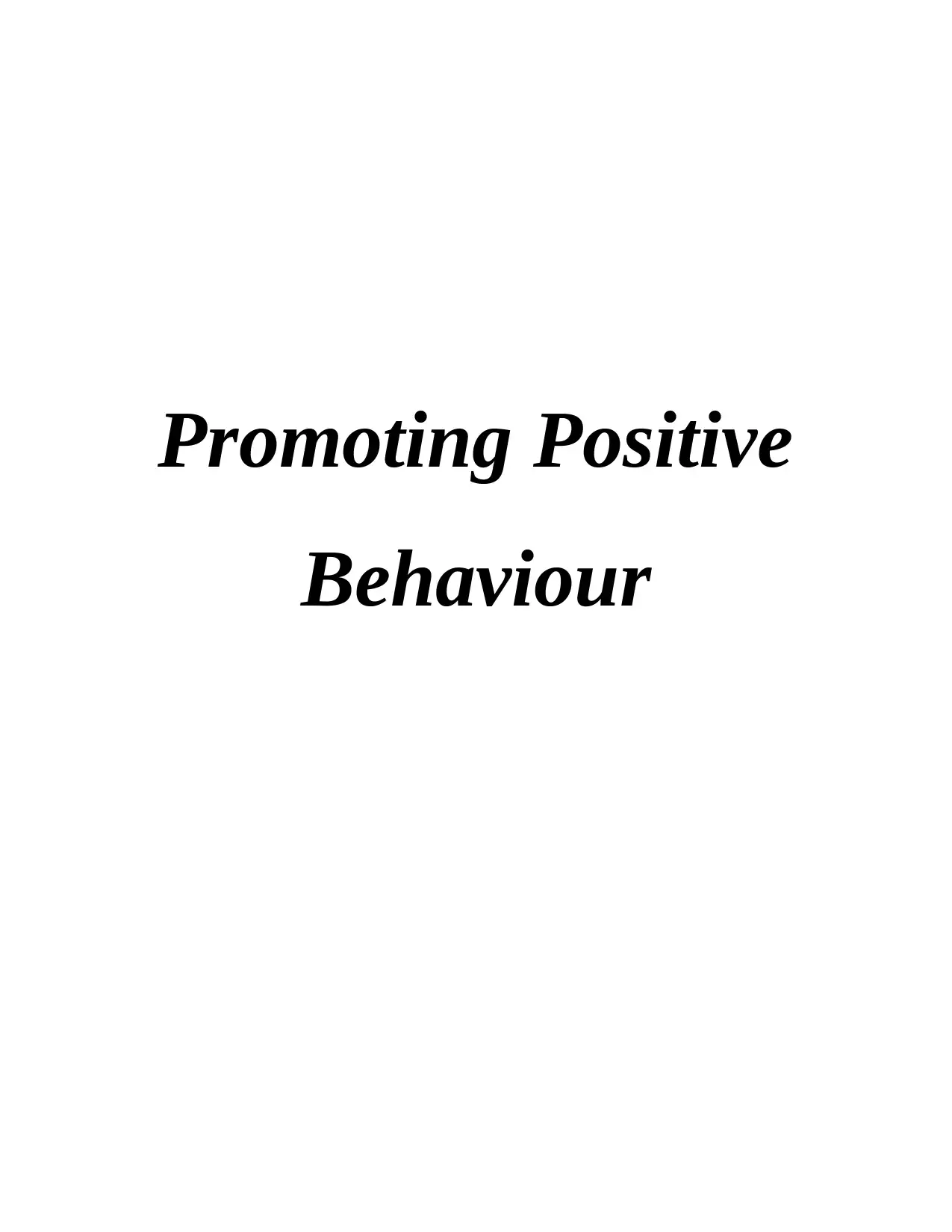
Promoting Positive
Behaviour
Behaviour
Secure Best Marks with AI Grader
Need help grading? Try our AI Grader for instant feedback on your assignments.
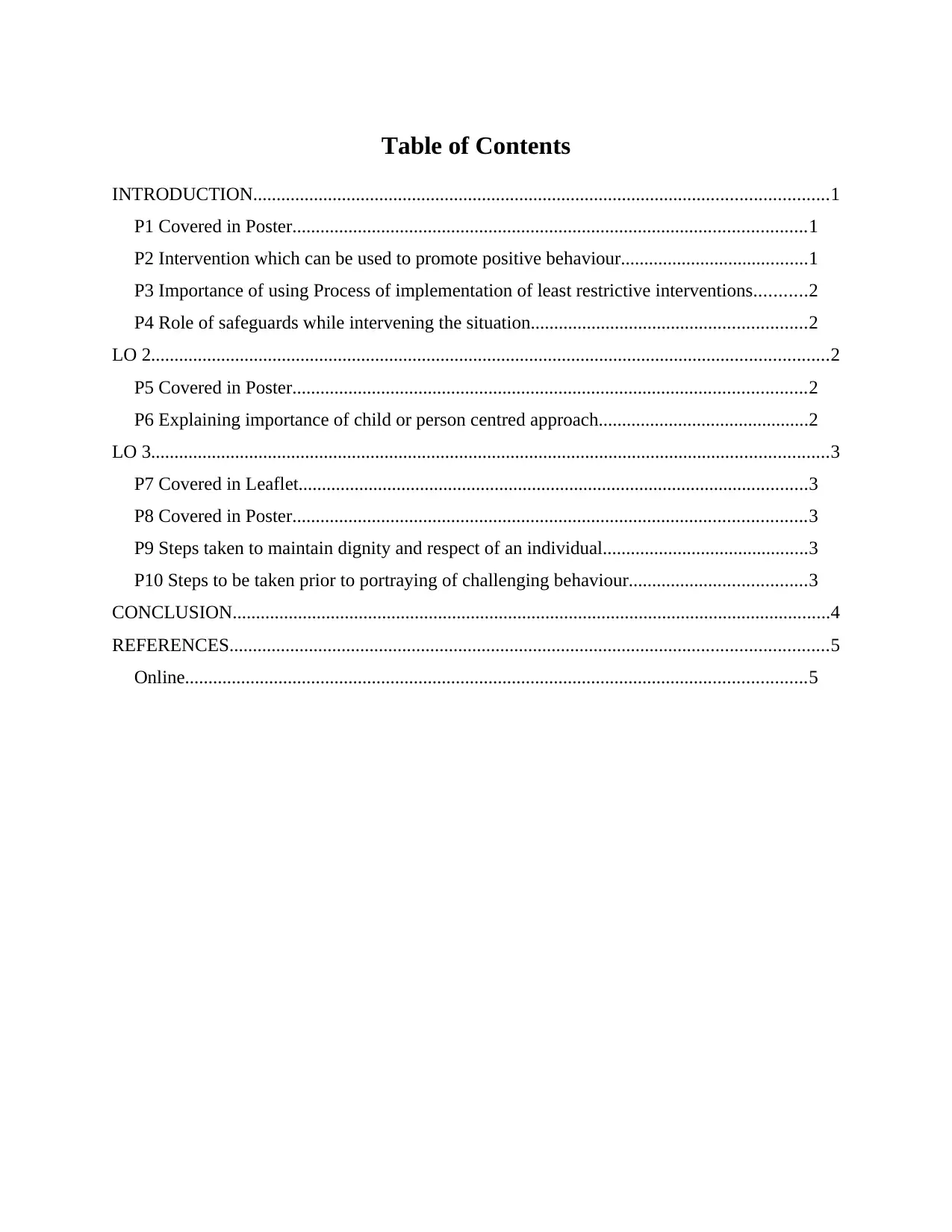
Table of Contents
INTRODUCTION...........................................................................................................................1
P1 Covered in Poster..............................................................................................................1
P2 Intervention which can be used to promote positive behaviour........................................1
P3 Importance of using Process of implementation of least restrictive interventions...........2
P4 Role of safeguards while intervening the situation...........................................................2
LO 2.................................................................................................................................................2
P5 Covered in Poster..............................................................................................................2
P6 Explaining importance of child or person centred approach.............................................2
LO 3.................................................................................................................................................3
P7 Covered in Leaflet.............................................................................................................3
P8 Covered in Poster..............................................................................................................3
P9 Steps taken to maintain dignity and respect of an individual............................................3
P10 Steps to be taken prior to portraying of challenging behaviour......................................3
CONCLUSION................................................................................................................................4
REFERENCES................................................................................................................................5
Online.....................................................................................................................................5
INTRODUCTION...........................................................................................................................1
P1 Covered in Poster..............................................................................................................1
P2 Intervention which can be used to promote positive behaviour........................................1
P3 Importance of using Process of implementation of least restrictive interventions...........2
P4 Role of safeguards while intervening the situation...........................................................2
LO 2.................................................................................................................................................2
P5 Covered in Poster..............................................................................................................2
P6 Explaining importance of child or person centred approach.............................................2
LO 3.................................................................................................................................................3
P7 Covered in Leaflet.............................................................................................................3
P8 Covered in Poster..............................................................................................................3
P9 Steps taken to maintain dignity and respect of an individual............................................3
P10 Steps to be taken prior to portraying of challenging behaviour......................................3
CONCLUSION................................................................................................................................4
REFERENCES................................................................................................................................5
Online.....................................................................................................................................5
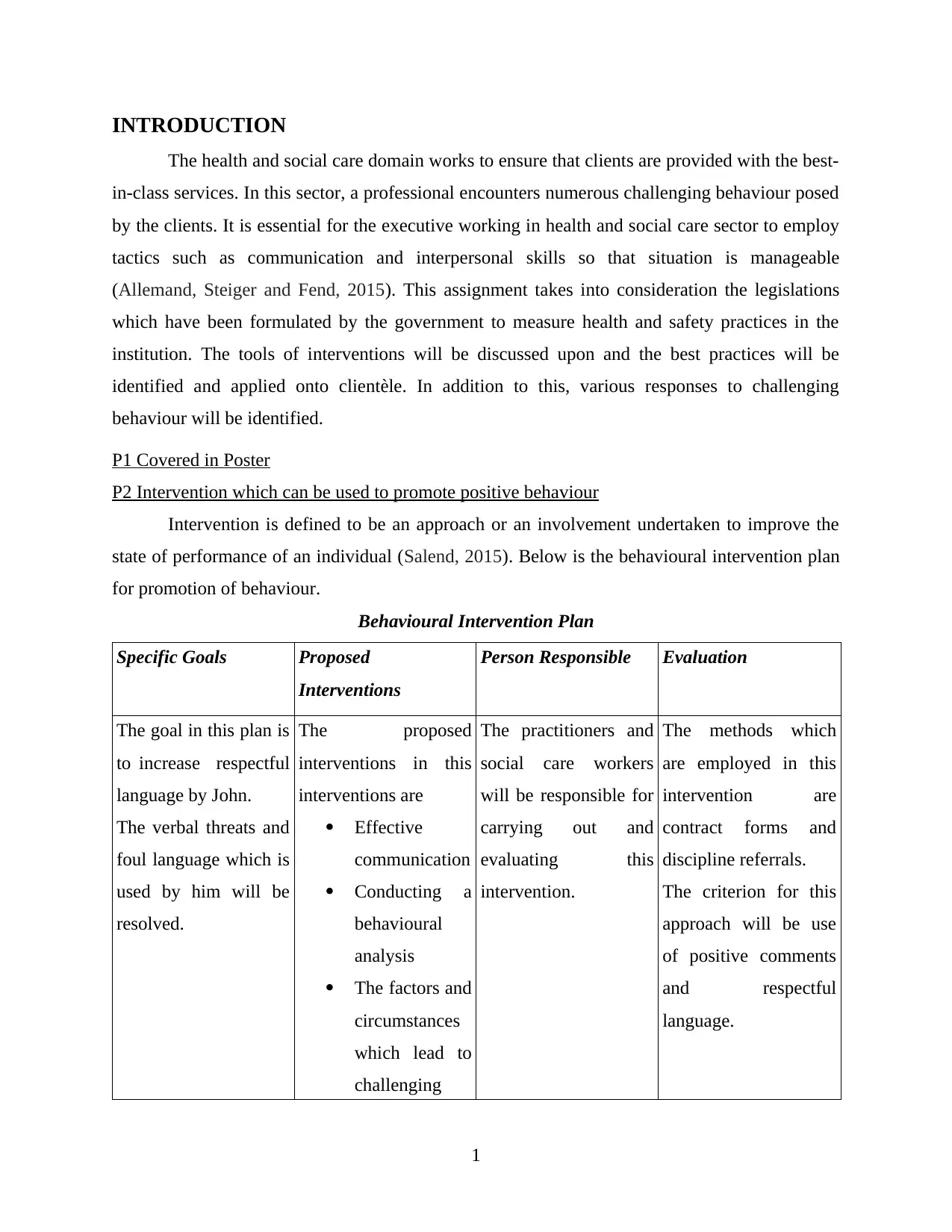
INTRODUCTION
The health and social care domain works to ensure that clients are provided with the best-
in-class services. In this sector, a professional encounters numerous challenging behaviour posed
by the clients. It is essential for the executive working in health and social care sector to employ
tactics such as communication and interpersonal skills so that situation is manageable
(Allemand, Steiger and Fend, 2015). This assignment takes into consideration the legislations
which have been formulated by the government to measure health and safety practices in the
institution. The tools of interventions will be discussed upon and the best practices will be
identified and applied onto clientèle. In addition to this, various responses to challenging
behaviour will be identified.
P1 Covered in Poster
P2 Intervention which can be used to promote positive behaviour
Intervention is defined to be an approach or an involvement undertaken to improve the
state of performance of an individual (Salend, 2015). Below is the behavioural intervention plan
for promotion of behaviour.
Behavioural Intervention Plan
Specific Goals Proposed
Interventions
Person Responsible Evaluation
The goal in this plan is
to increase respectful
language by John.
The verbal threats and
foul language which is
used by him will be
resolved.
The proposed
interventions in this
interventions are
Effective
communication
Conducting a
behavioural
analysis
The factors and
circumstances
which lead to
challenging
The practitioners and
social care workers
will be responsible for
carrying out and
evaluating this
intervention.
The methods which
are employed in this
intervention are
contract forms and
discipline referrals.
The criterion for this
approach will be use
of positive comments
and respectful
language.
1
The health and social care domain works to ensure that clients are provided with the best-
in-class services. In this sector, a professional encounters numerous challenging behaviour posed
by the clients. It is essential for the executive working in health and social care sector to employ
tactics such as communication and interpersonal skills so that situation is manageable
(Allemand, Steiger and Fend, 2015). This assignment takes into consideration the legislations
which have been formulated by the government to measure health and safety practices in the
institution. The tools of interventions will be discussed upon and the best practices will be
identified and applied onto clientèle. In addition to this, various responses to challenging
behaviour will be identified.
P1 Covered in Poster
P2 Intervention which can be used to promote positive behaviour
Intervention is defined to be an approach or an involvement undertaken to improve the
state of performance of an individual (Salend, 2015). Below is the behavioural intervention plan
for promotion of behaviour.
Behavioural Intervention Plan
Specific Goals Proposed
Interventions
Person Responsible Evaluation
The goal in this plan is
to increase respectful
language by John.
The verbal threats and
foul language which is
used by him will be
resolved.
The proposed
interventions in this
interventions are
Effective
communication
Conducting a
behavioural
analysis
The factors and
circumstances
which lead to
challenging
The practitioners and
social care workers
will be responsible for
carrying out and
evaluating this
intervention.
The methods which
are employed in this
intervention are
contract forms and
discipline referrals.
The criterion for this
approach will be use
of positive comments
and respectful
language.
1
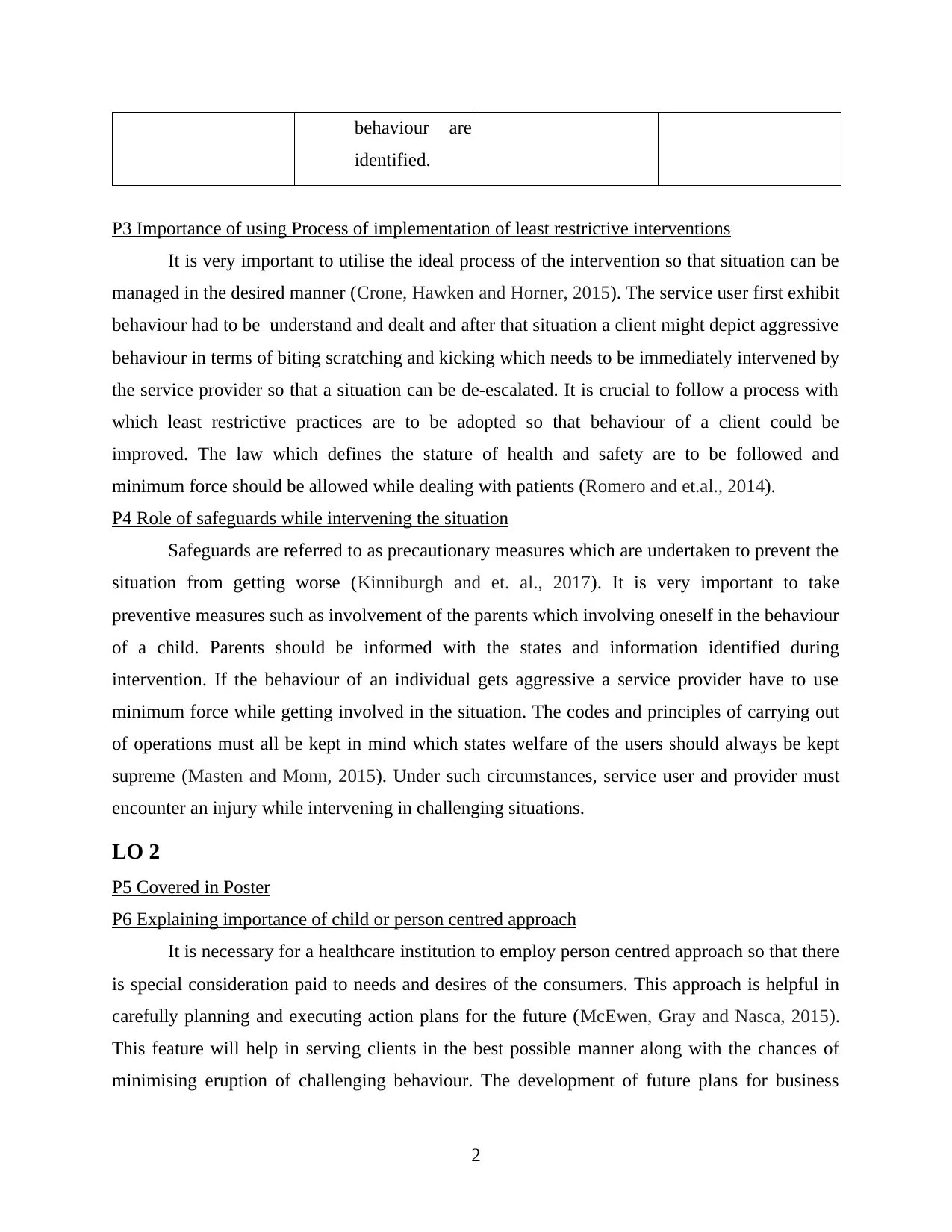
behaviour are
identified.
P3 Importance of using Process of implementation of least restrictive interventions
It is very important to utilise the ideal process of the intervention so that situation can be
managed in the desired manner (Crone, Hawken and Horner, 2015). The service user first exhibit
behaviour had to be understand and dealt and after that situation a client might depict aggressive
behaviour in terms of biting scratching and kicking which needs to be immediately intervened by
the service provider so that a situation can be de-escalated. It is crucial to follow a process with
which least restrictive practices are to be adopted so that behaviour of a client could be
improved. The law which defines the stature of health and safety are to be followed and
minimum force should be allowed while dealing with patients (Romero and et.al., 2014).
P4 Role of safeguards while intervening the situation
Safeguards are referred to as precautionary measures which are undertaken to prevent the
situation from getting worse (Kinniburgh and et. al., 2017). It is very important to take
preventive measures such as involvement of the parents which involving oneself in the behaviour
of a child. Parents should be informed with the states and information identified during
intervention. If the behaviour of an individual gets aggressive a service provider have to use
minimum force while getting involved in the situation. The codes and principles of carrying out
of operations must all be kept in mind which states welfare of the users should always be kept
supreme (Masten and Monn, 2015). Under such circumstances, service user and provider must
encounter an injury while intervening in challenging situations.
LO 2
P5 Covered in Poster
P6 Explaining importance of child or person centred approach
It is necessary for a healthcare institution to employ person centred approach so that there
is special consideration paid to needs and desires of the consumers. This approach is helpful in
carefully planning and executing action plans for the future (McEwen, Gray and Nasca, 2015).
This feature will help in serving clients in the best possible manner along with the chances of
minimising eruption of challenging behaviour. The development of future plans for business
2
identified.
P3 Importance of using Process of implementation of least restrictive interventions
It is very important to utilise the ideal process of the intervention so that situation can be
managed in the desired manner (Crone, Hawken and Horner, 2015). The service user first exhibit
behaviour had to be understand and dealt and after that situation a client might depict aggressive
behaviour in terms of biting scratching and kicking which needs to be immediately intervened by
the service provider so that a situation can be de-escalated. It is crucial to follow a process with
which least restrictive practices are to be adopted so that behaviour of a client could be
improved. The law which defines the stature of health and safety are to be followed and
minimum force should be allowed while dealing with patients (Romero and et.al., 2014).
P4 Role of safeguards while intervening the situation
Safeguards are referred to as precautionary measures which are undertaken to prevent the
situation from getting worse (Kinniburgh and et. al., 2017). It is very important to take
preventive measures such as involvement of the parents which involving oneself in the behaviour
of a child. Parents should be informed with the states and information identified during
intervention. If the behaviour of an individual gets aggressive a service provider have to use
minimum force while getting involved in the situation. The codes and principles of carrying out
of operations must all be kept in mind which states welfare of the users should always be kept
supreme (Masten and Monn, 2015). Under such circumstances, service user and provider must
encounter an injury while intervening in challenging situations.
LO 2
P5 Covered in Poster
P6 Explaining importance of child or person centred approach
It is necessary for a healthcare institution to employ person centred approach so that there
is special consideration paid to needs and desires of the consumers. This approach is helpful in
carefully planning and executing action plans for the future (McEwen, Gray and Nasca, 2015).
This feature will help in serving clients in the best possible manner along with the chances of
minimising eruption of challenging behaviour. The development of future plans for business
2
Secure Best Marks with AI Grader
Need help grading? Try our AI Grader for instant feedback on your assignments.
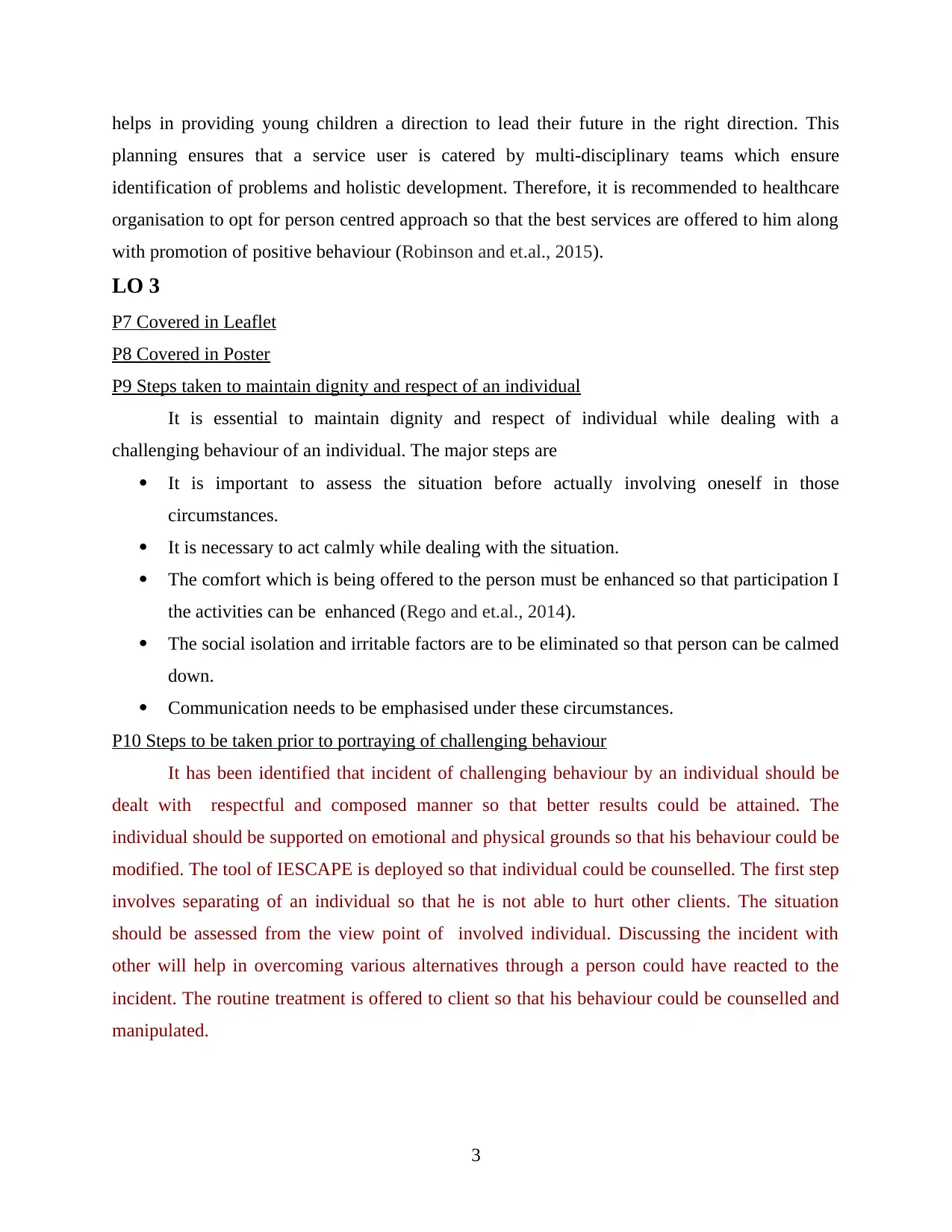
helps in providing young children a direction to lead their future in the right direction. This
planning ensures that a service user is catered by multi-disciplinary teams which ensure
identification of problems and holistic development. Therefore, it is recommended to healthcare
organisation to opt for person centred approach so that the best services are offered to him along
with promotion of positive behaviour (Robinson and et.al., 2015).
LO 3
P7 Covered in Leaflet
P8 Covered in Poster
P9 Steps taken to maintain dignity and respect of an individual
It is essential to maintain dignity and respect of individual while dealing with a
challenging behaviour of an individual. The major steps are
It is important to assess the situation before actually involving oneself in those
circumstances.
It is necessary to act calmly while dealing with the situation.
The comfort which is being offered to the person must be enhanced so that participation I
the activities can be enhanced (Rego and et.al., 2014).
The social isolation and irritable factors are to be eliminated so that person can be calmed
down.
Communication needs to be emphasised under these circumstances.
P10 Steps to be taken prior to portraying of challenging behaviour
It has been identified that incident of challenging behaviour by an individual should be
dealt with respectful and composed manner so that better results could be attained. The
individual should be supported on emotional and physical grounds so that his behaviour could be
modified. The tool of IESCAPE is deployed so that individual could be counselled. The first step
involves separating of an individual so that he is not able to hurt other clients. The situation
should be assessed from the view point of involved individual. Discussing the incident with
other will help in overcoming various alternatives through a person could have reacted to the
incident. The routine treatment is offered to client so that his behaviour could be counselled and
manipulated.
3
planning ensures that a service user is catered by multi-disciplinary teams which ensure
identification of problems and holistic development. Therefore, it is recommended to healthcare
organisation to opt for person centred approach so that the best services are offered to him along
with promotion of positive behaviour (Robinson and et.al., 2015).
LO 3
P7 Covered in Leaflet
P8 Covered in Poster
P9 Steps taken to maintain dignity and respect of an individual
It is essential to maintain dignity and respect of individual while dealing with a
challenging behaviour of an individual. The major steps are
It is important to assess the situation before actually involving oneself in those
circumstances.
It is necessary to act calmly while dealing with the situation.
The comfort which is being offered to the person must be enhanced so that participation I
the activities can be enhanced (Rego and et.al., 2014).
The social isolation and irritable factors are to be eliminated so that person can be calmed
down.
Communication needs to be emphasised under these circumstances.
P10 Steps to be taken prior to portraying of challenging behaviour
It has been identified that incident of challenging behaviour by an individual should be
dealt with respectful and composed manner so that better results could be attained. The
individual should be supported on emotional and physical grounds so that his behaviour could be
modified. The tool of IESCAPE is deployed so that individual could be counselled. The first step
involves separating of an individual so that he is not able to hurt other clients. The situation
should be assessed from the view point of involved individual. Discussing the incident with
other will help in overcoming various alternatives through a person could have reacted to the
incident. The routine treatment is offered to client so that his behaviour could be counselled and
manipulated.
3
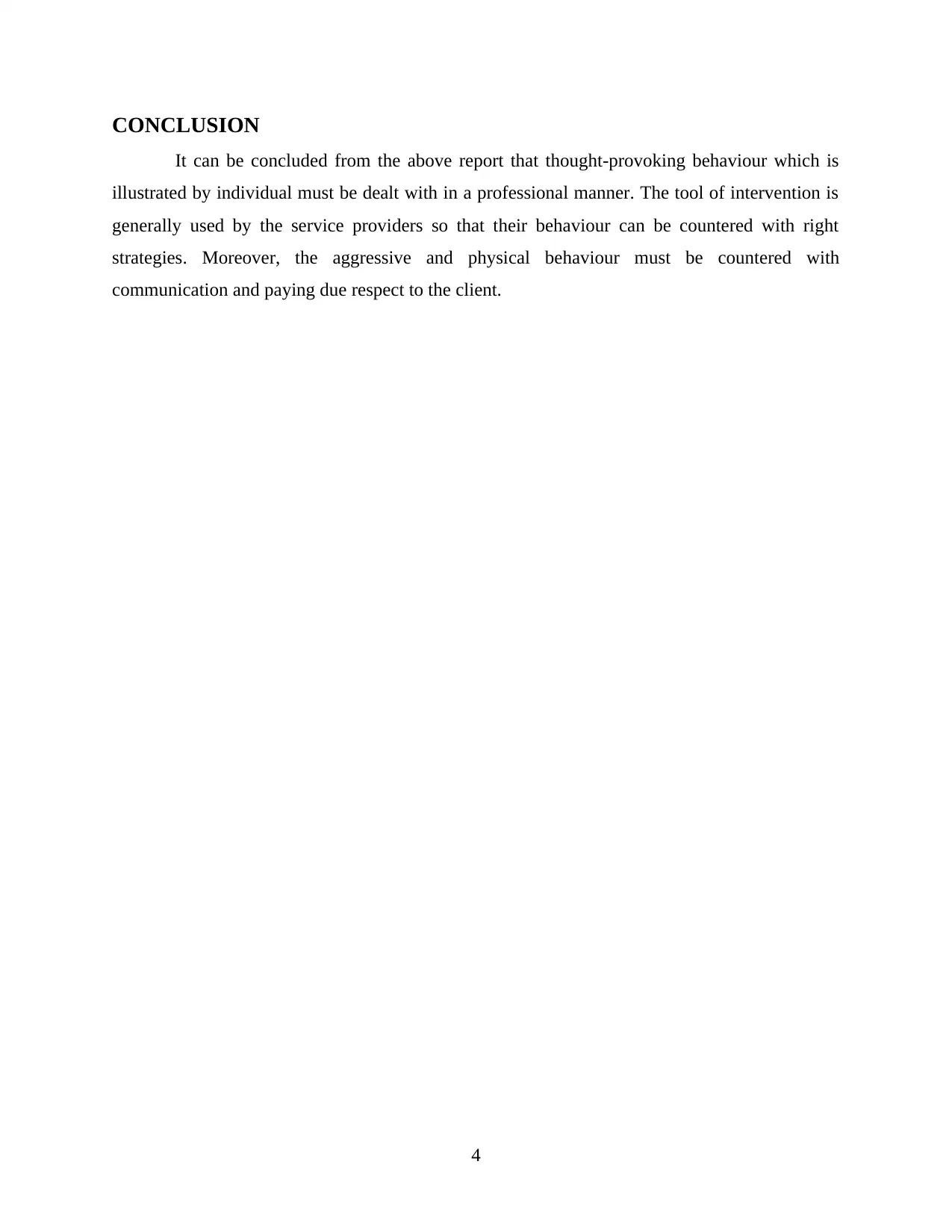
CONCLUSION
It can be concluded from the above report that thought-provoking behaviour which is
illustrated by individual must be dealt with in a professional manner. The tool of intervention is
generally used by the service providers so that their behaviour can be countered with right
strategies. Moreover, the aggressive and physical behaviour must be countered with
communication and paying due respect to the client.
4
It can be concluded from the above report that thought-provoking behaviour which is
illustrated by individual must be dealt with in a professional manner. The tool of intervention is
generally used by the service providers so that their behaviour can be countered with right
strategies. Moreover, the aggressive and physical behaviour must be countered with
communication and paying due respect to the client.
4
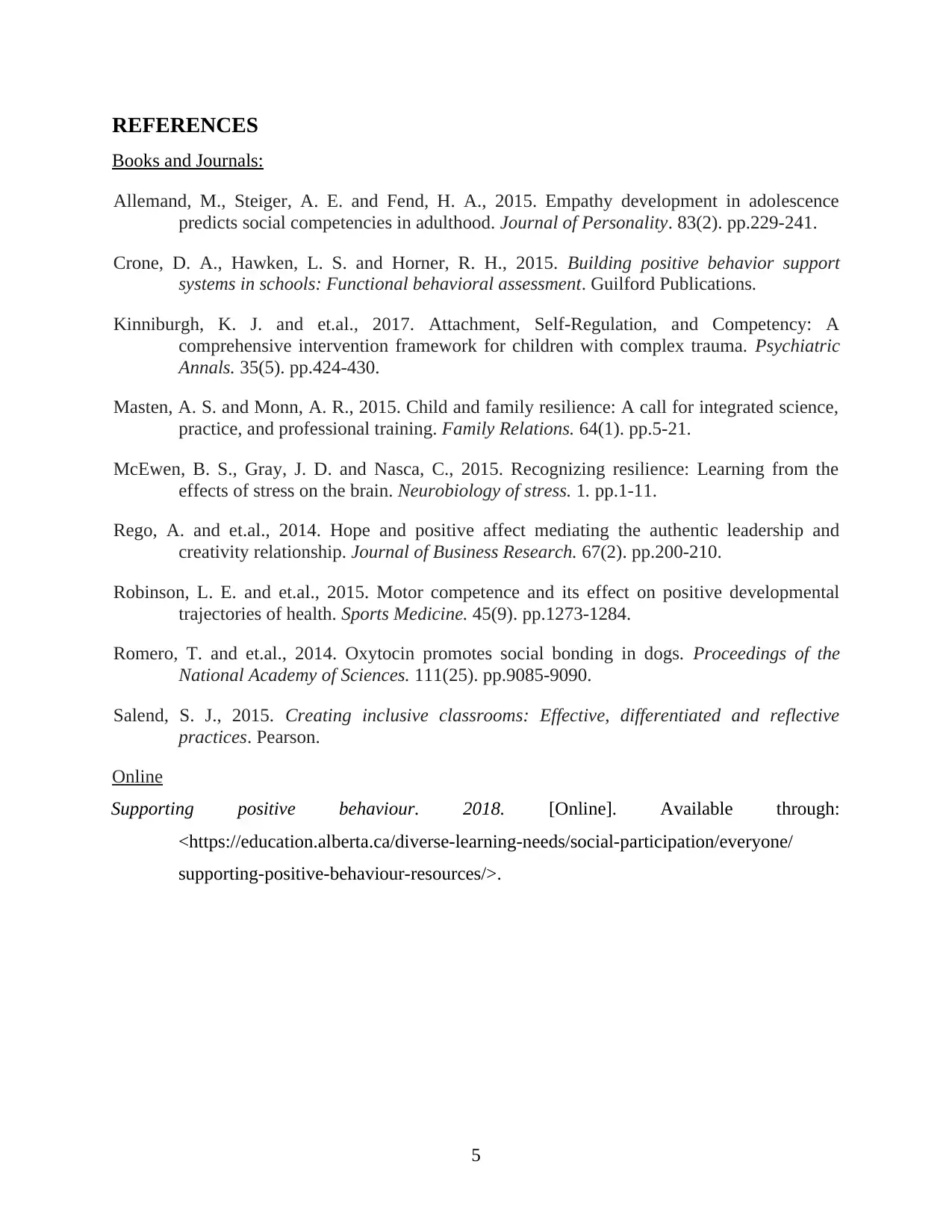
REFERENCES
Books and Journals:
Allemand, M., Steiger, A. E. and Fend, H. A., 2015. Empathy development in adolescence
predicts social competencies in adulthood. Journal of Personality. 83(2). pp.229-241.
Crone, D. A., Hawken, L. S. and Horner, R. H., 2015. Building positive behavior support
systems in schools: Functional behavioral assessment. Guilford Publications.
Kinniburgh, K. J. and et.al., 2017. Attachment, Self-Regulation, and Competency: A
comprehensive intervention framework for children with complex trauma. Psychiatric
Annals. 35(5). pp.424-430.
Masten, A. S. and Monn, A. R., 2015. Child and family resilience: A call for integrated science,
practice, and professional training. Family Relations. 64(1). pp.5-21.
McEwen, B. S., Gray, J. D. and Nasca, C., 2015. Recognizing resilience: Learning from the
effects of stress on the brain. Neurobiology of stress. 1. pp.1-11.
Rego, A. and et.al., 2014. Hope and positive affect mediating the authentic leadership and
creativity relationship. Journal of Business Research. 67(2). pp.200-210.
Robinson, L. E. and et.al., 2015. Motor competence and its effect on positive developmental
trajectories of health. Sports Medicine. 45(9). pp.1273-1284.
Romero, T. and et.al., 2014. Oxytocin promotes social bonding in dogs. Proceedings of the
National Academy of Sciences. 111(25). pp.9085-9090.
Salend, S. J., 2015. Creating inclusive classrooms: Effective, differentiated and reflective
practices. Pearson.
Online
Supporting positive behaviour. 2018. [Online]. Available through:
<https://education.alberta.ca/diverse-learning-needs/social-participation/everyone/
supporting-positive-behaviour-resources/>.
5
Books and Journals:
Allemand, M., Steiger, A. E. and Fend, H. A., 2015. Empathy development in adolescence
predicts social competencies in adulthood. Journal of Personality. 83(2). pp.229-241.
Crone, D. A., Hawken, L. S. and Horner, R. H., 2015. Building positive behavior support
systems in schools: Functional behavioral assessment. Guilford Publications.
Kinniburgh, K. J. and et.al., 2017. Attachment, Self-Regulation, and Competency: A
comprehensive intervention framework for children with complex trauma. Psychiatric
Annals. 35(5). pp.424-430.
Masten, A. S. and Monn, A. R., 2015. Child and family resilience: A call for integrated science,
practice, and professional training. Family Relations. 64(1). pp.5-21.
McEwen, B. S., Gray, J. D. and Nasca, C., 2015. Recognizing resilience: Learning from the
effects of stress on the brain. Neurobiology of stress. 1. pp.1-11.
Rego, A. and et.al., 2014. Hope and positive affect mediating the authentic leadership and
creativity relationship. Journal of Business Research. 67(2). pp.200-210.
Robinson, L. E. and et.al., 2015. Motor competence and its effect on positive developmental
trajectories of health. Sports Medicine. 45(9). pp.1273-1284.
Romero, T. and et.al., 2014. Oxytocin promotes social bonding in dogs. Proceedings of the
National Academy of Sciences. 111(25). pp.9085-9090.
Salend, S. J., 2015. Creating inclusive classrooms: Effective, differentiated and reflective
practices. Pearson.
Online
Supporting positive behaviour. 2018. [Online]. Available through:
<https://education.alberta.ca/diverse-learning-needs/social-participation/everyone/
supporting-positive-behaviour-resources/>.
5
1 out of 7
Related Documents
Your All-in-One AI-Powered Toolkit for Academic Success.
+13062052269
info@desklib.com
Available 24*7 on WhatsApp / Email
![[object Object]](/_next/static/media/star-bottom.7253800d.svg)
Unlock your academic potential
© 2024 | Zucol Services PVT LTD | All rights reserved.





